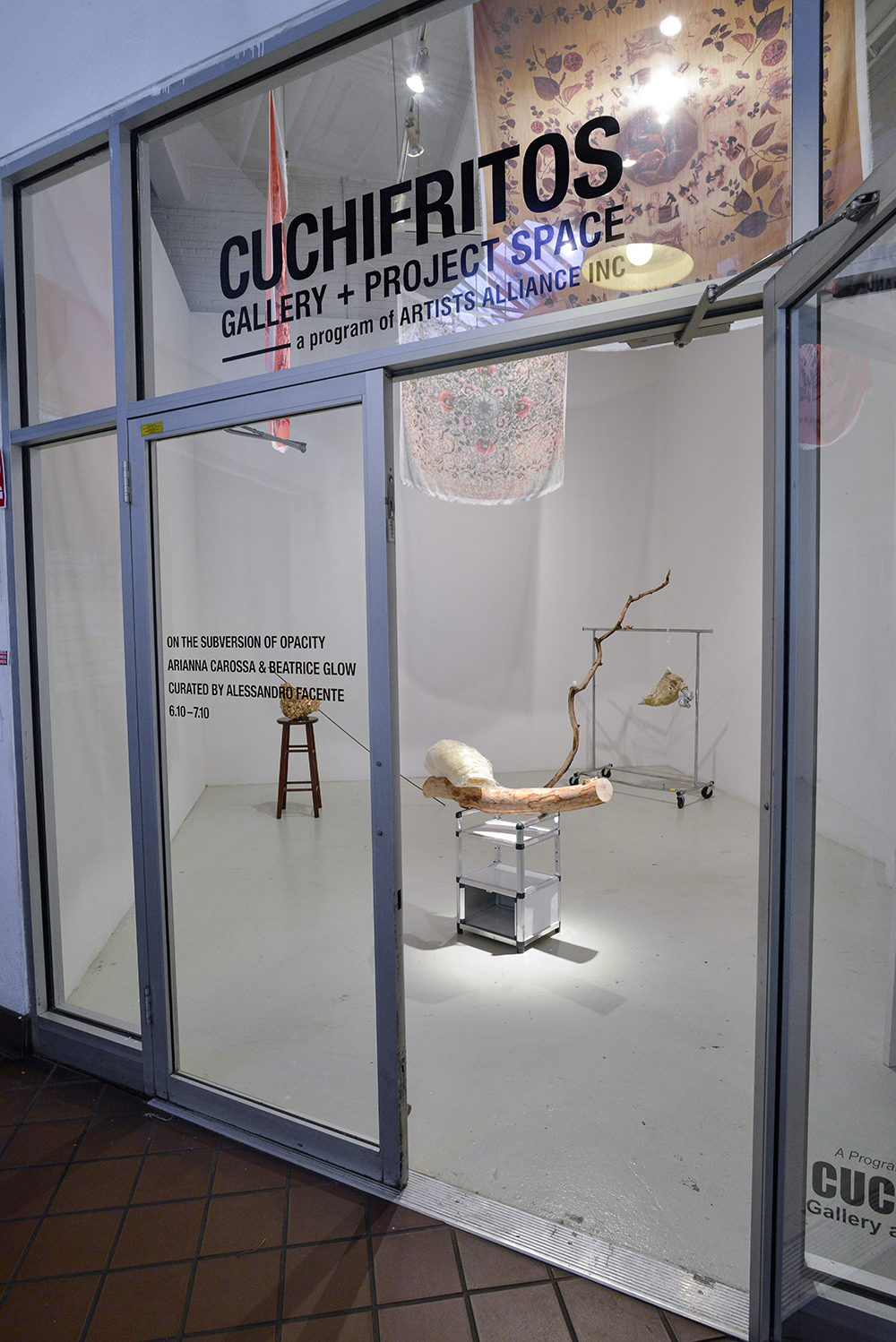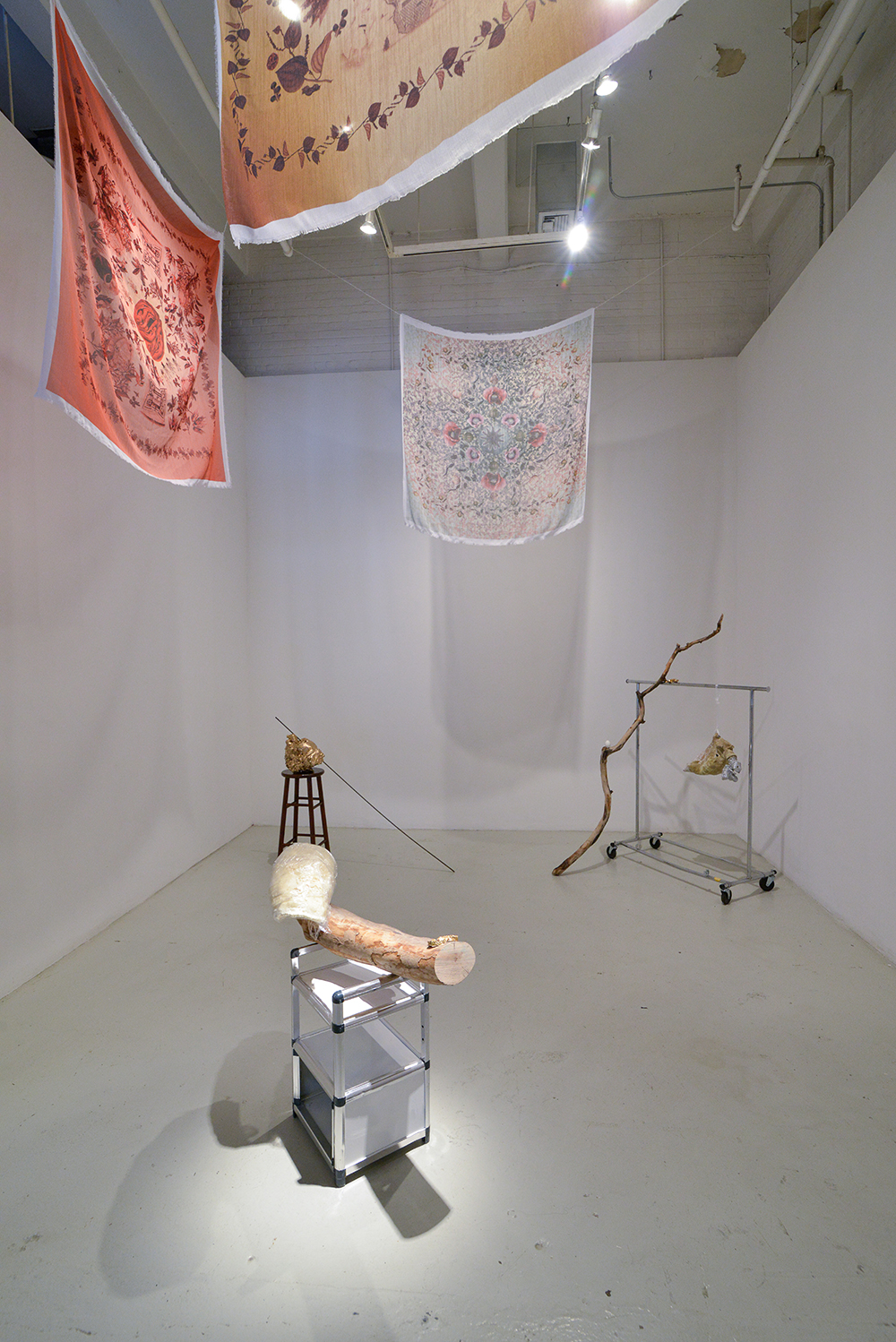Featuring recent work by Arianna Carossa and Beatrice Glow
Curated by Alessandro Facente
Presented as part of the Workspace 2016 series, featuring the work of LES Studio Program artist-in-residence Arianna Carossa and alumna Beatrice Glow.
Exhibition Dates: June 10 – July 10, 2016
Gallery Hours: Tuesday through Sunday, 12-6pm
Location: 120 Essex Street NY, NY 10002 (inside Essex Street Market)
Recent Press
Droste Effect “on the subversion of opacity at Cuchifritos Gallery + Project Space”
“With myths, one should not be in a hurry. It is better to let them settle into the memory, to stop and dwell on every detail, to reflect on them without losing touch with their language of images. The lesson we can learn from a myth lies in the literal narrative, not in what we add to it from the outside.” (Italo Calvino, “Lightness,” from Six Memos for the Next Millennium, 1988)
Cuchifritos Gallery + Project Space is thrilled to present on the subversion of opacity [About Practice#3], a two-person exhibition of recent work by Arianna Carossa and Beatrice Glow, curated by Alessandro Facente.
Through site-specific installations, including sculpture and digital prints on silk, this exhibition considers the ways in which artists provide an indirect view of reality, representing it as a fictional mythology drawn from its facts, forms, or histories, but never reflecting them directly. Even as a fiction, this mythology is able, perhaps even more so, to reveal the original reality at its core; an inner essence not beholden to its usual context, interpretation or common understanding. Instead, the new work behaves as autonomous form; an expanded field that is both in balance and in tension with the one from which it has been originally generated.
By investigating the ways in which reality can become dissociated from recognizable forms and ordinary knowledge, the exhibition considers the manual labor, or craft, within an artist’s practice and its potential to modify, shape, overturn, and radically change an existing object, shape or event (historical or current) in the process. Estranged from their original context, the former lives of these objects and histories become transparent, yielding their political, social or practical nature to an intimacy between the viewer and the visual experience where the form is observed without additional interpretation and description, nor the mediation of “what we add to it from the outside.”
In his 1988 essay “Lightness,” published in the compendium Six Memos for the Next Millennium, Italo Calvino likens the writer’s creative act to an indirect gaze on the world; just as Perseus defeated Medusa by following her movement in the reflection of his shield, the strength of the literary imagination is in a writer’s ability to wade through the opacity of our literal world through the transformation of fact into fiction; subverting what Calvino describes as the “petrification” or “the weight” of ideas through the lightness of mythology and its visionary language.
Similarly, Arianna Carossa and Beatrice Glow’s works aim to experiment with personal formalism, creating new worlds that encourage the viewer to exceed their own assumptions within an exhibition space.
Across her entire practice, from site-specific projects to sculptures to land art, Arianna Carossa strives to create work that emerges from the environment in which she is called to realize a project, aiming at searching for situations or moments where the design of an object itself can relate to everything around it. For many years, at the center of her research there has been the object: intended as raw material to be reinvented through different forms and expressions. Her process is strongly rooted in Arte Povera, but completely reinterpreted through a language which is profoundly personal and carefully aimed at investigating new materials, such as found objects, pieces of furniture, ceramics and paintings reassembled as a reflection on universal themes.
On the occasion of the show, Carossa exhibits a new body of organic/animal-like-shape sculptures made by using expanded foam, colors and found objects, whose interaction in the limits of both the piece and space, offer viewers mixed feelings, based on a balance between opposite forces, including dirty and clean, hard and soft, bright and opaque, weight and light.
Beatrice Glow uncovers invisible and suppressed stories that lie in the long geopolitical shadows of colonialism and migration. Her practice comprises sculptural installations, trilingual publishing, lectures and participatory performances. To counter divisive discussions of political and cultural borders, Glow meditates on how all ethnospheres are, like islands, connected beneath the surface. Her research mines the relationship between Asia and the Americas, investigating transpacific economic and cultural circulations, as well as persistent, romanticized notions of the exotic “other.”
Glow’s installation at Cuchifritos consists of a new body of work that tells the social history of spices as a bloody continuum of exploitation, extraction, and land dispossession. She created a series of digital prints on silk drawing upon historical depictions of the spice trade combined with her own drawings that are inspired by botanical research to illuminate the transhistoric weight of spices, silks and colors that have propelled forward countless caravans and ships in the birthing of globalization. The artist considers these silk prints as objects that sit between the resemblance of Mantones de Manila and oriental rugs, objects that embody a long history of trade, cultural circulations and mystique. The transparent and weightless quality of silk evokes the ghosts of history that invisibly shape our present while starkly contrasting historical gravity.
* * *
ARIANNA CAROSSA was born in 1973 in Genova, where she lived and worked at the beginning of her career. In 2011 she moved to New York and since then she continued her research in the United States, developing parallel projects in Europe during the same time. For many years, at the center of her research there has been the object: intended as raw material to be reinvented, a process rooted in Arte Povera, completely reinterpreted. Common materials and pieces of furniture, ceramics and paintings are reassembled in a personal way, reflecting on universal themes. As of today, without losing sight of the object, her focus shifted to the loss of imagination caused by reality being fully revealed; after the publication of the book “The aesthetic of my disappearance”, launched in 2014 by the MoMA / PS1, her attention focused to performing art related to the object, making the audience familiar and uneasy at the same time.
BEATRICE GLOW’s interdisciplinary art practice comprises sculptural installations, trilingual publishing, participatory and lecture performances, and augmented/virtual reality immersive experiences. Her research mines the relationship between Asia and the Americas, investigating transpacific economic and cultural circulations, as well as questioning the representation of indigenous realities in colonial aesthetics. She earned a BFA in studio art from New York University, and is the incoming 2016-2017 Artist in Residence at the University’s Asian/Pacific/American Institute. Recent activities include The Wayfinding Project at New York University to map the Lenape Trail that is now Broadway; Expert at Creative Tech Week; Artist in Residence at LES Studio Program, a program of Artists Alliance Inc., New York, NY; Van Lier Visual Art Fellow at Wave Hill, Bronx, NY; finalist for the Joan Mitchell Foundation Emerging Artist Award; digital publishing with the Museum of Modern Art, New York, NY; and lecture performances at Asia Society, New York, NY; and “My Art Guide: Venice Meeting Point, “56th Venice Biennale. Her work has been featured in recent exhibitions at Momenta Art, Brooklyn, NY; Bronx Museum of the Arts; Zebrastraat Gallery, Gent, Belgium; El Museo del Barrio, New York, NY; and Museo de Arte Contemporaneo de Arequipa, Peru. In 2014, Glow received the Franklin Furnace Fund to organize the Floating Library, a pop-up public space with free programming aboard the Lilac Museum Steamship, New York, NY. As a Hemispheric Institute of Performance and Politics’ Council Member she also helped launch the Performing Asian/Americas workgroup in 2014 at the Encuentro 2014 in Montreal. In 2008–9, she was awarded a Fulbright scholarship to pursue a research-creation project in Peru on Asian Latin America. She is preparing for an upcoming solo exhibit at the Museo Nacional de Bellas Artes de Chile in 2016.
ALESSANDRO FACENTE is an art critic and independent curator who lives in New York and works between New York, Morocco and Italy. His research focuses on the crossover and interplay of art criticism and curatorship by following the artist’s practice from the concept to the final creation of the piece of art. A curatorial theory that he named ‘curaticism’. He is currently Curator at Atla(s)now project on the Moroccan Atlas Mountains. Facente has curated solo, group exhibitions and talks in non-profit spaces, foundations, galleries and museums, including the 5th Marrakech Biennale, HIAP in Helsinki, TranzitDisplay in Prague, Residency Unlimited and Cuchifritos Gallery in New York. His articles, interviews and essays have appeared in art magazines such as Artribune, DROME magazine, Exibart and DOMUS.
on the subversion of opacity is the third iteration of the large-scale curatorial project by Italian curator Alessandro Facente entitled About Practice, a series of group shows about ongoing studies and theories on the artist’s practice in relation to reality. As a chronological stratification of stories composed over time, the artist’s practice is can be understood as an argumentative substrate in its own right, which prompts the curator to critically outline the philology of the show starting from the topics which first arise from the artist’s practice itself. Such a joint approach of production and theory transforms About Practice into a series of exhibitions focused on the notion of concept, its role and position in the artwork as an intrinsic consequence of constant activity that develops its own theory as it unfolds.
* * *
Cuchifritos Gallery + Project Space is FREE to the public and handicap accessible. Located inside Essex Street Market at the south end nearest Delancey. Cuchifritos Gallery + Project Space is a program of Artists Alliance Inc., a 501c3 not for profit organization located on the Lower East Side of New York City within the Clemente Soto Vélez Cultural and Educational Center. Cuchifritos is supported in part by the New York City Department of Cultural Affairs in partnership with the City Council. This program is made possible by public funds from the New York State Council on the Arts and the National Endowment for the Arts. We thank the following for their generous support: Marie and John Zimmermann Fund, Gilbert MacKay Foundation, New York City Economic Development Corporation and individual supporters of Artists Alliance Inc. Special thanks go to our team of dedicated volunteers, without whom this program would not be possible.
















